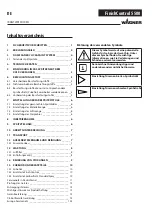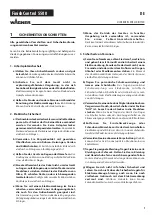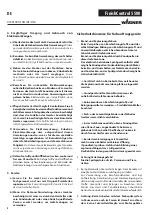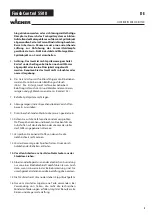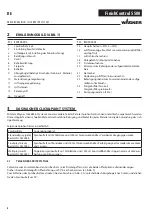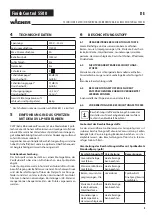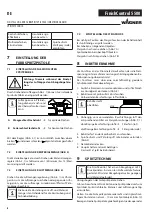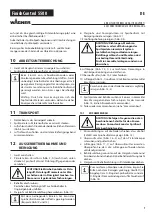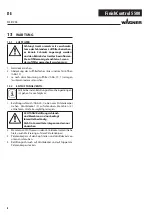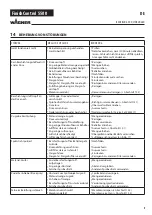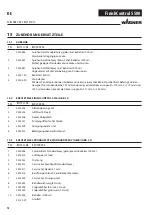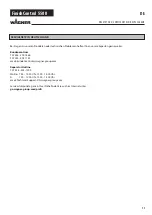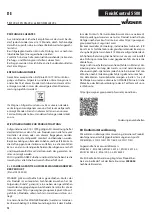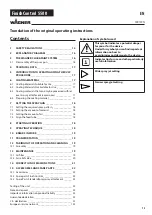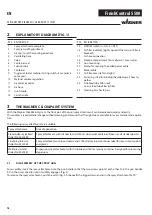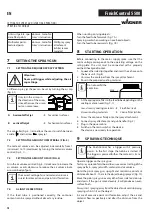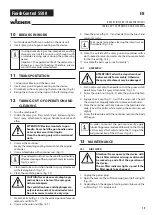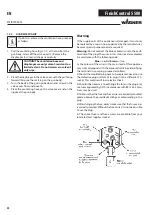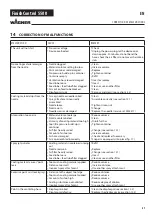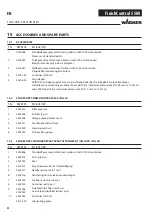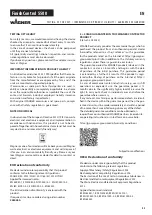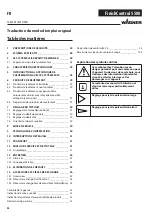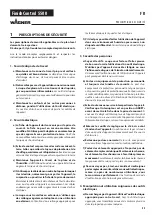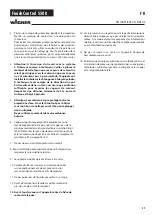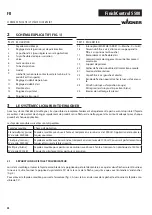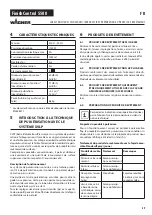
14
FinishControl 5500
EN
1
SAFETY REGULATIONS
All local safety regulations in force must be observed.
Read the operating instructions carefully and follow the in-
structions laid down in them in order to avoid risks.
1. Safety at the workplace
a) Keep your workplace clean and well lit.
Disorder or unlit workplaces may result in accidents.
b) Never use the tool in hazardous areas that contain
flammable liquids, gases or dusts.
Power tools generate
sparks that can ignite the dust or vapors.
c) Keep children and other persons away when using
the power tool.
You can lose control of the tool if you are
distracted.
2. Electrical Safety
a) The tool plug must fit into the socket. The plug may
not be modified in any form. Do not use adaptor plugs
together with protective-earthed tools.
Unmodified
plugs and suitable sockets reduce the risk of an electric shock.
b) Avoid physical contact with earthed surfaces such as
pipes, heating elements, stoves and refrigerators.
The
risk through electric shock increases if your body is earthed.
c) Keep the equipment away from rain and moisture.
The
risk of an electric shock increases if water penetrates electrical
equipment.
d) Do not misuse the mains lead by carrying the tool by
the lead, hanging it from the lead or by pulling on
the lead to remove the plug. Keep the lead away from
heat, oil, sharp edges or moving tool parts.
Damaged
or twisted leads increase the risk of an electric shock.
e) If you work outdoors with a power tool, only use
extension cables suitable for outdoor use.
The use of
an extension lead that is suitable for outdoors reduces the
risk of an electric shock.
f) ) If you cannot avoid using the tool in a damp
environment, use a residual current operated circuit-
breaker.
Using a residual current operated circuit-breaker
avoids the risk of electric shock.
3. Safety of Persons
a) Be attentive. Pay attention to what you are doing and
work sensibly with a power tool. Do not use the tool if
you are tired or under the influence of drugs, alcohol or
medication.
Just a moment of inattentiveness while using
the tool can lead to serious injuries.
b) Wear personal safety equipment and always wear
safety goggles.
Wearing personal protective equipment,
such as dust mask, non-slip safety shoes, safety helmet or
ear protection, depending on the type of power tools, reduces
the risk of injury.
c) Avoid accidental starting-up. Ensure that the switch
is in the “OFF” position before inserting the plug into
the socket.
Accidents can occur if you carry the power tool
while your finger is on the switch or if you connect the power
tool to the power supply which it is on.
d) Remove setting tools or wrenches before switching on
the power tool.
A tool or wrench that is in a rotating tool
part can lead to injuries.
e) Avoid an unnatural posture.
This ensures that you can
control the tool better in unexpected situations.
f) Wear suitable clothing. Do not wear wide clothing or
jewellery. Keep your hair, clothes and gloves away
from moving parts.
Loose clothing, jewellery or long hair
can be caught in moving parts.
g) Do not lull yourself into a false sense of security and
do not think yourself above the safety rules for electric
tools, even if you are familiar with the electric tool
following extensive practical experience.
Careless use
can lead to serious injuries in fractions of a second.
4. Careful Handling and Use of Power Tools
a) Do not overload the tool. Use the power tool designed
for the work that you are doing.
You work better and safer
in the specified performance range if you use the suitable
power tool.
b) Do not use power tools whose switch is defective.
A
power tool that cannot be switched on or off is dangerous
and has to be repaired.
c) Remove the plug from the socket before carrying out
tool settings, changing accessories or putting the tool
away.
This precautionary measure prevents unintentional
starting of the tool.
d) Store unused power tools so that they are inaccessible
to children. Do not let persons use the tool who
are not familiar with it or who have not read these
instructions.
Power tools are dangerous when they are used
by inexperienced persons.
e) Take proper care of your tools. Check whether the
moving parts function trouble-free and do not jam,
whether parts are broken or damaged so that the tool
function is impaired.
Have damaged parts repaired before
using the tool. Many accidents have their origin in power
tools that have been maintained badly.
f) Use the power tool, accessories, insert tools, etc. in
accordance with these instructions and in a fashion
specified for this special tool type. Take the working
conditions and the activity to be carried out into
consideration.
The use of power tools for purposes other
than the intended ones can lead to dangerous situations.
g) Keep the handles and grip surfaces dry, clean and
free of oil and grease.
Slippery handles and grip surfaces
hamper safe operation and control of the electric tool in
unforeseen situations.
5. Service
a) Have your tool repaired only by qualified specialist
SAFETY REGULATIONS
Summary of Contents for FINISH CONTROL 5500
Page 3: ...FinishControl 5500 A B 2 1 1 1 1 3 10 cm 1 2 1 2...
Page 4: ...FinishControl 5500 r 1 q 1 s 1 3 2 2 6 1 5 3...
Page 5: ...FinishControl 5500 3 2 1 2 1 4 5 6 1 2 4 7 8 9 10 5 t 1 3 6 3...
Page 113: ...107 FinishControl 5500 RU 1 1 a b c 2 a b c d e f 3 a b c d e f g...
Page 114: ...108 FinishControl 5500 RU 4 a b c d e f g 5 a b 1 2...
Page 115: ...109 FinishControl 5500 RU 3 4 3 5 6 1 4 13 2 7 8 9 10 11 12 13 14 15 16...
Page 121: ...115 FinishControl 5500 RU 14 30 13 2 12 1 2434517 13 1 17...
Page 125: ...119 FinishControl 5500 RU 4 Wagner 5 18 88677...
Page 126: ...120 FinishControl 5500 RU...
Page 127: ...121 FinishControl 5500 RU...

